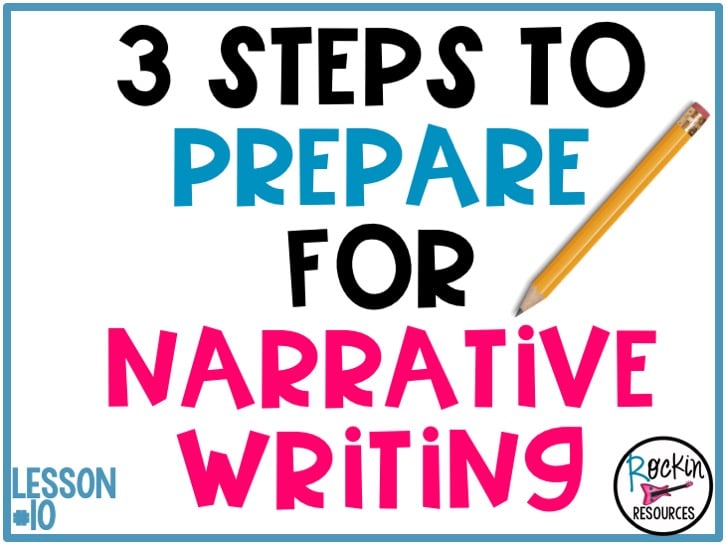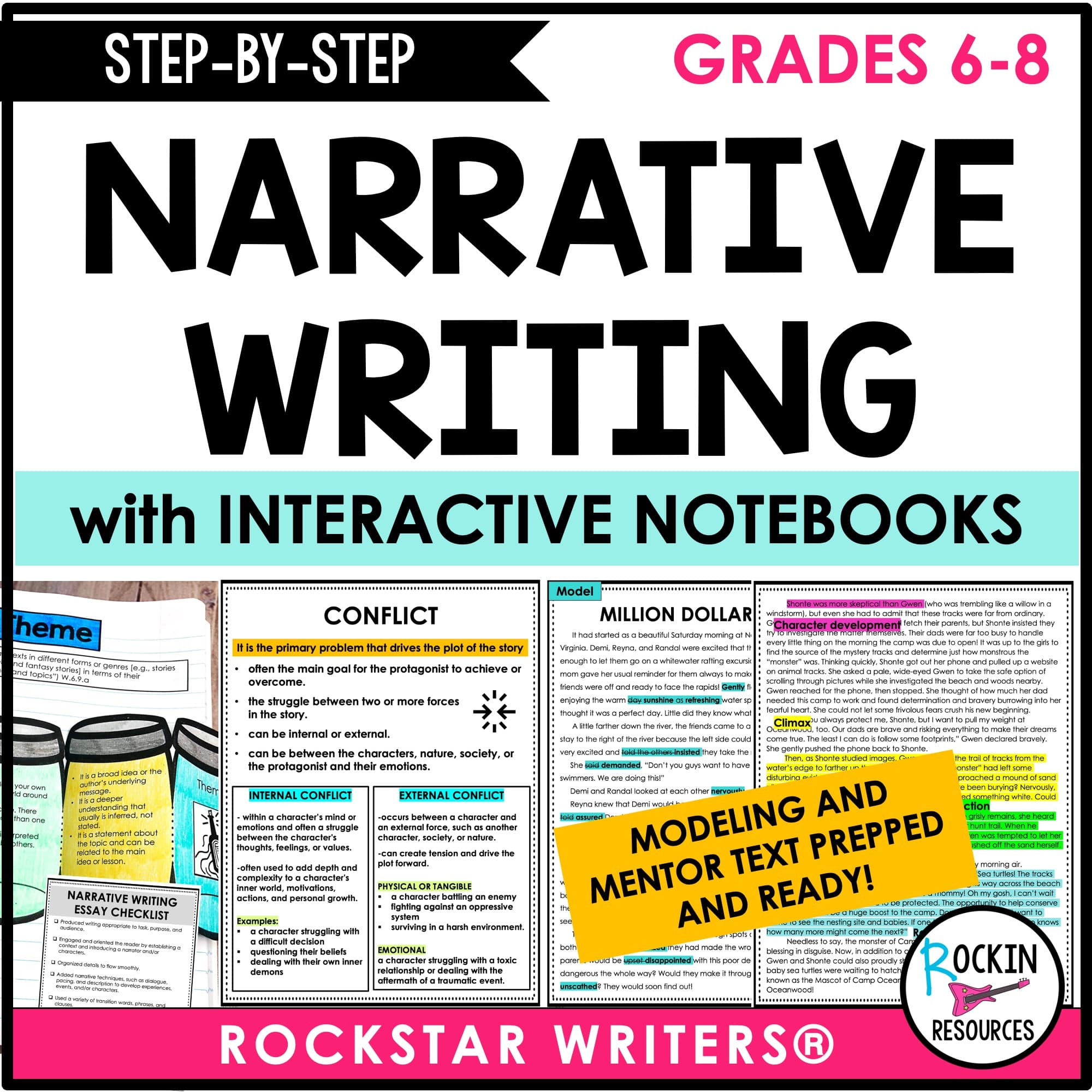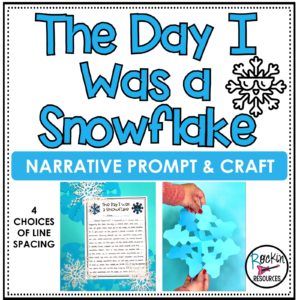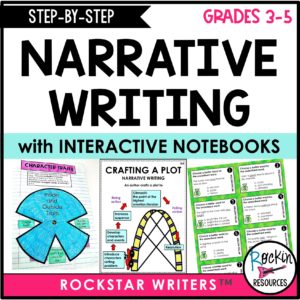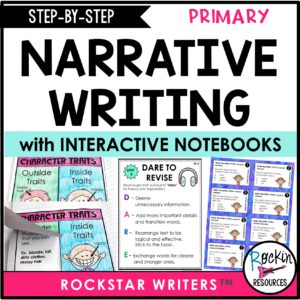If you’re here, you’re probably wondering, “What is narrative writing?” You’re just in luck, because I LOVE writing! Writing is my jam! In most elementary curricula, you will find the THREE basic types of writing: Narrative, Opinion, and Informative. This post will focus on NARRATIVE writing. We will cover WHAT NARRATIVE WRITING IS AND HOW TO TEACH IT!
What is NARRATIVE WRITING?
Narrative writing is when we tell a STORY. In a narrative piece, there should be a main event in which the main character faces some sort of problem or compelling experience and it gets resolved and/or a lesson is learned at the end. This type of writing usually includes a narrator, other characters, a setting, and a plot. It is organized chronologically to depict a storyline with a beginning, middle, and end. Let’s take a look at Narrative Elements.
- Tells a story using time
- Has a beginning, middle, and end
- Can be real or imaginary
- Uses story elements: narrator, characters, setting, problem, solution
- Crafts a plot
- Has vivid descriptions of events, scenes, objects, and people
- May include dialogue
- May convey a message or lesson learned
How do you teach NARRATIVE WRITING?
We’ve covered WHAT narrative writing is, now let’s learn HOW to teach it!
First, we want to explain to our students what narrative writing is and what the purpose is for writing this type of text. The author’s purpose for narrative writing is to entertain, so explain that they need to be creative and provide vivid descriptions of everything in their stories. This will paint a picture in the reader’s mind.
Then teach mini-lessons throughout the writing process to build the narrative piece. Narrative writing should include:
Exciting Beginning: Yes, start off the story by introducing the main character, setting, and problem. However, students should write it to grab the reader’s attention! Make it exciting! Try onomatopoeia, a question, or a shocker.
Body: Create 3 events that follow a plot of rising action and suspense, climax, and falling action. This is the middle of the story, where it comes alive and is exciting! Students should express the tension and elaborate details of each of the events.
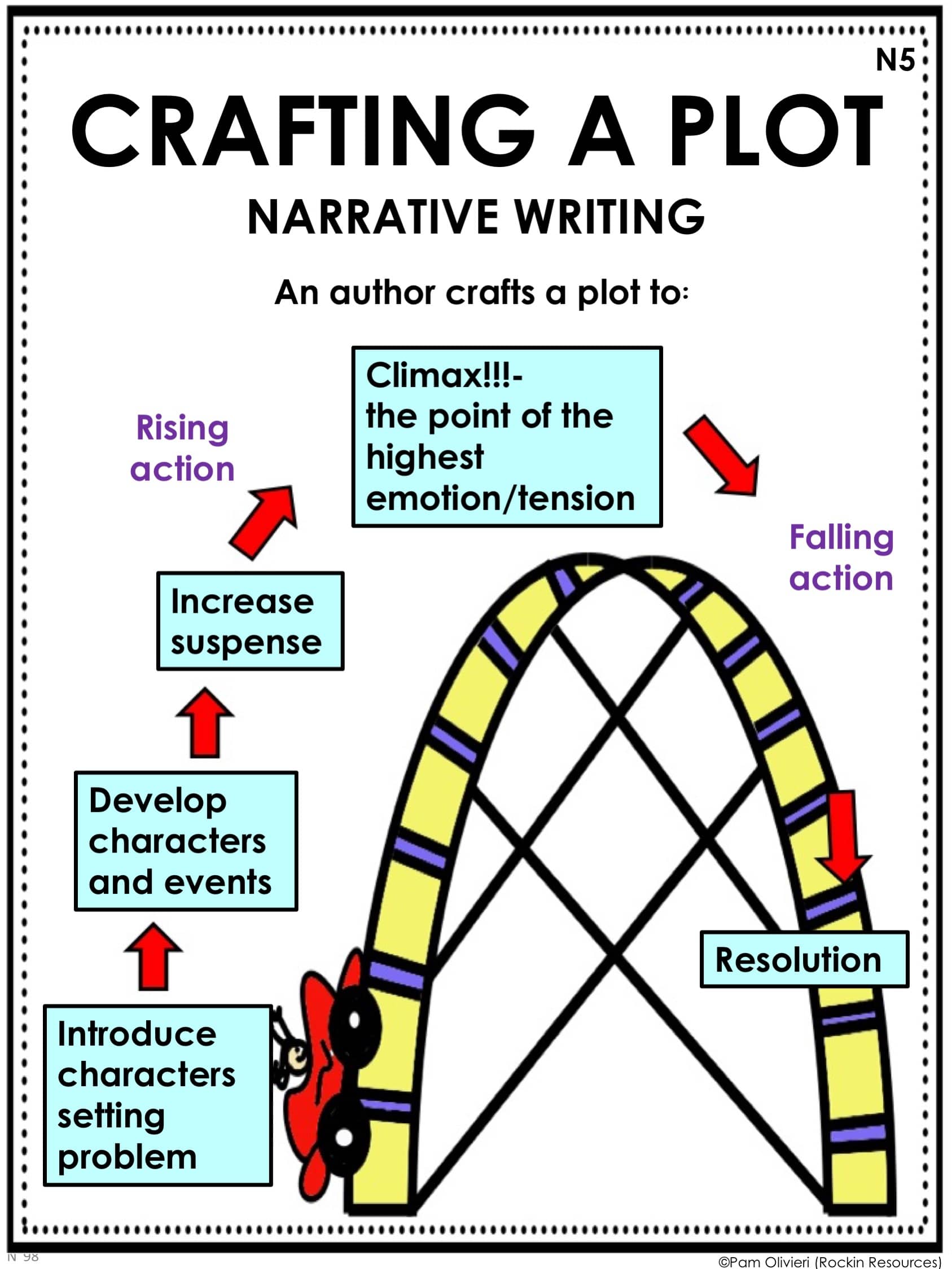
Develop Characters: Find ways to show changes in the characters throughout the story. Describe their actions, thoughts, and feelings.
Transition Words: Add words that can help the story flow and stay organized. For example: in the beginning, at the same time, later on, in the end.
Dialogue: Add meaningful dialogue in the body. Dialogue shouldn’t be used if it is stating the obvious. It can reveal a character’s personality or show the tension in the story.
Word Choice: Create imagery in the story by adding descriptive adjectives, adverbs, and verbs. Even add figurative language and sense words! This is when students will paint a picture with words. Provide a thesaurus and available word lists to help them with imagery.
Variety of Sentences: Sentences shouldn’t all start the same way. Try a variety. It shouldn’t say. He did this. He did that. He was here. He was there. Blah Blah Blah. Try starting with a describing word, a transition word, or write a question.
Creative Conclusion: Write the ending to the story, but end it with a bang! Get creative. For example, include the lesson learned, a wish or a hope, what may happen in the future, etc.
Example of Narrative Writing
For inspiration, I’m grabbing a July narrative writing prompt from my Monthly Writing Prompts resource.
I will use the following prompt:
National Ice Cream Day is the third Sunday in July. Pretend that you own an ice cream store. What would you do differently on that day? Write about the events of that day.
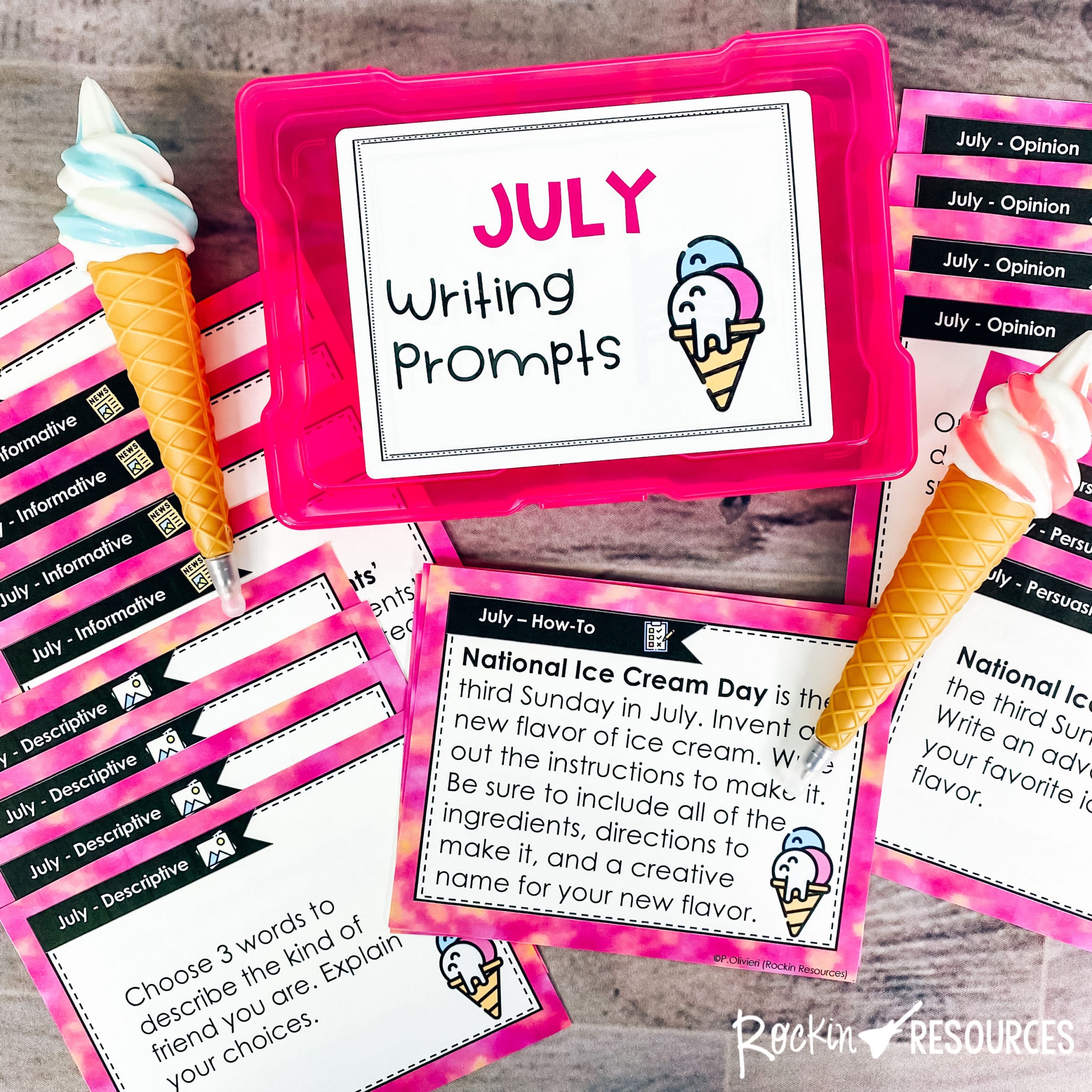
National Ice Cream Day? Now that is something ANYONE can write about! Many times, I offer a choice of narrative writing prompts to students. Think about it. Maybe you hand out a prompt asking students to write about a time they went on vacation. What if a student has never experienced a vacation? If we want all students to write, we need to make sure we offer them prompts that they have knowledge of or experience with to be able to write. This will help to avoid any writer’s block!
Narrative Writing Example:
Yum!!! It is National Ice Cream Day and I decided to sell my special peach ice cream in my parlor, Meg’s Creamery. My employees were helping to get everything ready, but then we realized something. James was missing.
First of all, the ice cream parlor was ready to open in 15 minutes. Where was James? He was in charge of my signature peach ice cream. Everyone scattered to help. Zac was quickly filling ice cream tubs in the display refrigerator. Demi shuffled quickly to make a few batches of fresh waffle cones. I placed the “fresh peach ice cream” sign in the front window and turned on the milkshake machines. Glancing over my shoulder, I saw the peach ice cream in the refrigerator, but James was nowhere in sight.
“TWO MINUTES! Everyone in place! Sales are expected to be HUGE today!” I shouted across the parlor. The store was close to opening and we still couldn’t find James. I remember telling him to make sure the two extra gallons of peach ice cream fit in the display refrigerator no matter what. I knew it would be a busy day. There was a line as long as a river outside.
Then, we found James out back slumped over two empty gallon-sized tubs of ice cream. He had a milk mustache and his face looked as green as a leprechaun. Frowning, he looked at me and said he had a tummy ache. When Demi asked him what happened, he said he ate the chocolate and vanilla ice cream, so the peach could fit. Laughing, I helped him up and told him to sit behind the counter and work the register.
At last, the doors opened and every time a customer asked for vanilla or chocolate, we kindly redirected them to the peach ice cream. We sold every ounce of peach ice cream that day. Celebrating with an ice cream party, even James had another scoop of ice cream. After all, it was National Ice Cream Day!
Identifying Narrative Elements
As you can see, this story is in chronological order. Let’s identify the story elements within this narrative piece.
Plot: Obstacles of opening an ice cream parlor on National Ice Cream Day.
Narrator: Meg, the ice cream parlor owner!
Setting: Ice cream parlor
Characters: Demi, Meg, James, Zac
Problem: James was missing. There was no chocolate and vanilla ice cream.
Solution: James was found. They advertised fresh peach ice cream.
Exciting Beginning: Yum!!! (Used onomatopoeia!) James was missing. (It grabs the readers’ attention. It has them wondering what happened.)
Body 1- Suspense- First of all, the ice cream parlor was ready to open in 15 minutes. Where was James? He was in charge of my signature peach ice cream. Everyone scattered to help. (It keeps the readers’ attention.)
Body 2– Climax- “TWO MINUTES! Everyone in place! Sales are expected to be HUGE today!” I shouted across the parlor. The store was close to opening and we still couldn’t find James. I remember telling him to make sure the two extra gallons of peach ice cream fit in the display refrigerator no matter what. (It gives clues and shows the excitement of opening the store. It keeps the reader wondering about James.)
Body 3- Falling Action- Then, we found James out back slumped over two empty gallon-sized tubs of ice cream. (They find James! It has the readers wondering what they will do with no chocolate or vanilla ice cream.
Character Development: James was following orders, then made a bad choice, then became helpful at the register.
Transition Words: First of all, then, at last, after all
Dialogue: “TWO MINUTES! Everyone in place! Sales are expected to be HUGE today!” I shouted across the parlor. (This is meaningful to the story and shows the excitement.)
Word Choice: scattered, glancing over my shoulder, a line as long as a river, shuffled, kindly, as green as a leprechaun, slumped
Variety of Sentences: Celebrating with an ice cream party, even James had another scoop of ice cream. After all, it was National Ice Cream Day!
Creative Conclusion: At last, the doors opened and every time a customer asked for vanilla or chocolate, we kindly redirected them to the peach ice cream. We sold every ounce of peach ice cream that day. Celebrating with an ice cream party, even James had another scoop of ice cream. After all, it was National Ice Cream Day! (It ends the story creatively.)
Now you know what narrative writing looks like! I hope you find it helpful when teaching narrative writing to your students!

SEE RELATED BLOG POSTS:
DISCOVER RELATED RESOURCES:
-
Monthly Writing Prompts
$9.99 -
Narrative Writing Grades 6-8
$19.99 -
Narrative Writing Mini Lesson Videos | Distance Learning
Original price was: $49.99.$29.99Current price is: $29.99.
SHARE THIS POST ON PINTEREST:




